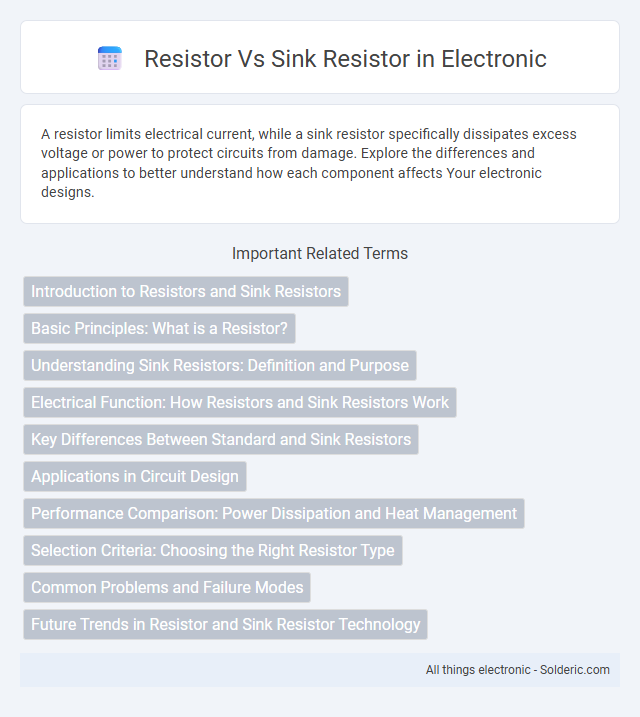A resistor limits electrical current, while a sink resistor specifically dissipates excess voltage or power to protect circuits from damage. Explore the differences and applications to better understand how each component affects Your electronic designs.
Comparison Table
| Feature | Resistor | Sink Resistor |
|---|---|---|
| Definition | Passive electrical component limiting current flow. | Specific resistor used to direct excess current to ground or sink. |
| Function | Controls voltage and current in circuits. | Absorbs or dissipates current to protect components. |
| Application | Voltage division, current limiting, signal conditioning. | Current sinking, protecting outputs, stabilizing circuits. |
| Placement | Anywhere in the circuit as needed. | Typically connected between signal line and ground. |
| Power Dissipation | Varies, depends on resistance and current. | Designed to safely dissipate excess power from sinking current. |
| Importance | Fundamental for controlling electrical parameters. | Essential for protecting circuits by managing excess current. |
Introduction to Resistors and Sink Resistors
Resistors regulate current flow and reduce voltage within electronic circuits to protect components and ensure stable operation. Sink resistors specifically serve to safely dissipate excess current or voltage, often in LED circuits or sensor systems, preventing damage by absorbing unwanted energy. Understanding the role of sink resistors helps you optimize circuit reliability and performance while managing power efficiently.
Basic Principles: What is a Resistor?
A resistor is a fundamental electrical component designed to limit current flow and reduce voltage within a circuit, ensuring other components operate safely. A sink resistor specifically dissipates excess energy as heat in applications such as LED circuits or voltage regulation to prevent damage. Understanding your circuit's current and voltage requirements helps determine the appropriate type of resistor for efficient and stable performance.
Understanding Sink Resistors: Definition and Purpose
Sink resistors regulate current flow by serving as a load to safely divert excess current away from sensitive components in electronic circuits. Unlike standard resistors that primarily control voltage and current within a circuit, sink resistors absorb and dissipate unwanted current, thereby protecting devices from damage due to overcurrent or signal interference. Their purpose is critical in ensuring stable operation and prolonging the lifespan of electronic systems by preventing overheating and ensuring reliable current management.
Electrical Function: How Resistors and Sink Resistors Work
Resistors limit the flow of electrical current by providing a specific resistance value, protecting circuits and controlling voltage levels. Sink resistors, often used in current sinking configurations, allow excess current to be safely dissipated by directing it to ground, preventing damage to sensitive components. Understanding how these resistors function electrically can help you design circuits with optimal current control and protection.
Key Differences Between Standard and Sink Resistors
Standard resistors primarily limit current and divide voltage in electronic circuits, maintaining precise resistance values for reliable performance. Sink resistors, also known as pull-down resistors, are specifically designed to ensure a defined logic level by safely directing excess current to ground in digital circuits. Key differences include their functional roles, with standard resistors serving general current control, while sink resistors maintain stable voltage references and prevent floating inputs in semiconductor devices.
Applications in Circuit Design
Resistors are fundamental components used to control current flow and divide voltage in various circuit designs, including signal conditioning and biasing applications. Sink resistors specifically serve as load resistors that dissipate excess current, protecting components by safely directing electrical energy to ground. Your circuit efficiency and protection improve significantly by selecting the appropriate type of resistor based on whether you need to regulate current or provide a reliable current sink.
Performance Comparison: Power Dissipation and Heat Management
Resistors and sink resistors differ significantly in power dissipation and heat management, with sink resistors designed specifically to handle higher power levels by efficiently dissipating heat through larger surface areas or heat sinks. Standard resistors may overheat and fail under high power loads due to limited thermal handling capabilities, whereas sink resistors maintain stable performance by optimizing thermal conductivity and minimizing temperature rise. Proper selection between these resistor types directly impacts circuit reliability and longevity in high-power applications.
Selection Criteria: Choosing the Right Resistor Type
Selecting the right resistor type depends on factors such as power dissipation, thermal management, and circuit design requirements. Standard resistors handle low to moderate power, while sink resistors are designed to absorb and dissipate higher heat loads efficiently, preventing damage to sensitive components. Your choice should consider the resistor's power rating, tolerance, and how effectively it manages heat within your specific application.
Common Problems and Failure Modes
Resistors often face issues like overheating and tolerance drift, which can lead to circuit instability, while sink resistors primarily encounter failures from excessive current flow causing thermal damage and eventual open circuits. Inaccurate resistance values in standard resistors affect voltage and current regulation, whereas sink resistor failures usually disrupt proper current sinking, impacting device protection. You should monitor temperature ratings and power dissipation limits closely to prevent common failure modes in both resistor types.
Future Trends in Resistor and Sink Resistor Technology
Emerging trends in resistor and sink resistor technology emphasize advancements in material science, such as the integration of graphene and carbon nanotubes for enhanced thermal stability and electrical conductivity. Innovations in miniaturization and smart resistor designs enable more efficient heat dissipation and adaptive resistance control in high-power electronic devices. The growing demand for energy-efficient and compact components in IoT and automotive applications drives the development of sink resistors with improved durability and integration capabilities.
resistor vs sink resistor Infographic

 solderic.com
solderic.com